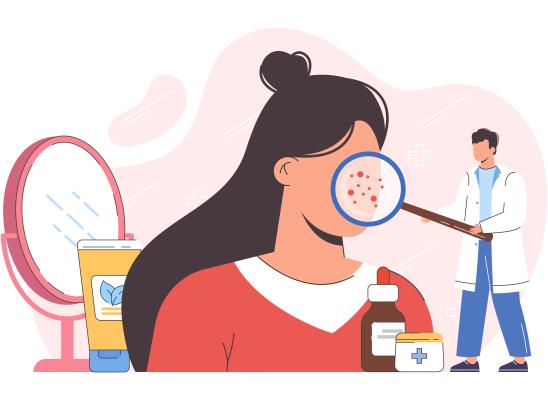
Online test
Find out the severity of your symptoms with this free online test
Skin picking is a body-focused repetitive behavior (BFRB) where someone recurrently and compulsively picks at their skin to the point of injury. Research has identified certain characteristics and factors associated with skin picking but it remains not well-understood and difficult to treat. The diagnostic criteria for skin picking disorder include, “the skin picking causes clinically significant distress or impairment in social, occupational, or other important areas of functioning.” What that actually means is highly dependent upon the individual and how they experience their skin picking. It’s not a “one-size-fits-all”.
What we know less about is the experience of skin picking. What is the experience like for those who live with the disorder? Researchers have wondered too. Empirical studies can offer information based on objective data. What empirical (quantitative) studies often miss is the subjective (qualitative) aspects of the disorder. What is the experience like for someone who picks?
Defining the experience of shame or guilt or distress is hard to quantify. Just what is that experience like and how does it affect the individual?
A recent study sought to try and answer that question.
The Study
Using information from people with a skin picking disorder, the study sought draw on their subjective experiences to answer the question, “What is the lived experience of problematic skin picking?”
Information was gathered using a semi-structured interview process with a choice of how participants completed their interview. Choices included WhatsApp or Messenger, email, phone, or Skype. This approach was used to support each individual’s level of comfort and to allow for participants to use their own language in describing their experiences.
Experiences Revealed
Three over-arching themes emerged:
- The Voice that Permits Picking: Cognitions Drive Picking and Undermine Resistance (the drive to pick)
- Switching Everything Else Off (the experience of picking)
- I Worry About People Looking and Judging Me: Distress in how Picking is Seen (the consequences of picking)
The Voice that Permits Picking: Cognitions Drive Picking and Undermine Resistance
This dimension explored the drive to pick. Picking behaviors were driven by thoughts and circumstances that allowed picking, and that diminished the will to stop. These experiences fell within three themes:
- Skin Texture Must Go – Their thoughts and attention to their skin motivated picking. Thoughts about skin texture seemed to be particularly common and a precursor to picking.
- ‘Oh Well’ and ‘So What’: Resignation to Picking – Participants reported patterns of thinking that contributed to a resignation to picking, that it was somehow inevitable, tolerable, or manageable. Interestingly, when picking was seen as less manageable, the behavior was reduced.
- Picking because I Can: Permissive Circumstances – Picking would happen whenever opportunity presented. Opportunity seemed to be a trigger to pick (e.g., free time or free hands)
Switching Everything Else Off – In the Zone
This dimension explored the experience of picking. Three main themes emerged:
- Zoning In to Zone Out – Many participants described having the experience of “zoning out” during picking episodes. This is in keeping with the previous findings related to automatic picking style and picking trances.
- It Comes with Negative Emotions - Picking was often associated with feelings of stress or distress. Participants reported that this zoned-out style of picking brought relief.
- Reducing Emotional and Mental Noise – Participants described picking as a means for coping or relaxation.
It is thought that zoning out is a radical example of experiential avoidance. When the person is engaged in picking, time seems to stand still, and all focus is on picking the skin. The person experiences relief from their emotional distress without having to deal with the stressors directly. That might seem like a good thing. However, the relief experienced from picking is short-lived. It’s followed by feelings of guilt and shame and emotional distress starts to build again. As a result, the picking episodes can become self-perpetuating.
I Worry About People Looking and Judging Me: Distress in how Picking is Seen
This dimension focused on how the person dealt with how their picking might be perceived by others. Hiding their picking and skin damage was behavior that many reported engaging in. Shame, embarrassment, and disgust seemed to be exacerbated by social interaction so avoiding social situations where their skin damage could be noticed was not uncommon. Two dominant themes emerged:
- Shame of Picking - Participants reported feeling self-conscious about their damaged skin which led to social avoidance and attempts to conceal their skin. Underlying thoughts included worries that others may think they are infectious or that they lacked self-control.
- I am Misunderstood – Many felt misunderstood by others. This led to frustration and a reluctance to seek help. They also reported feeling relief when they felt understood by others. This approach-avoid behavior can be a barrier to seeking help. On the one hand, help is desired. On the other, there’s a fear of being judged and misunderstood.
The study included a number of quotes from the participants that describe these dynamics and their experiences in their own words. They describe skin picking in ways quantitative research cannot. They give the reader a glimpse into the experience of skin picking.
What Experiential Information Means for Treatment
The goal of the study was to gain a better understanding of:
- Individual experiences of picking
- the relationships between these experiences
- the processes by which people understand their picking problem
These findings don’t negate what quantitative research has found. On the contrary, this type of qualitative research allows skin picking to be viewed through the lens of experience and how individual patterns of thinking can shape the course of their picking disorder. Not everyone will experience every aspect or in the same way.
Understanding both the quantitative and qualitative aspects of skin picking while respecting individual differences is pivotal in developing effective treatment plans that meet the individual’s needs and concerns. Treatment should be guided by their priorities, needs, strengths and goals.
Research like this offers hope for more effective, individually focused treatments for those living with skin picking and other BFRBs.
References
1. Anderson, S., Clarke, V., & Thomas, Z. (2022). The problem with picking: Permittance, escape and shame in problematic skin picking. Psychology and Psychotherapy: Theory, Research and Practice, 96(1), 83-100. https://bpspsychub.onlinelibrary.wiley.com/doi/pdfdirect/10.1111/papt.12427
2. SkinPick's October webinar: Exploring skin picking "Trances", pt. 1 [Video]. (2020, October 22). YouTube. https://youtu.be/yL2OaCVp1KE
Online test
Find out the severity of your symptoms with this free online test
Start your journey with SkinPick
Take control of your life and find freedom from skin picking through professional therapy and evidence-based behavioral techniques.
Start Now



